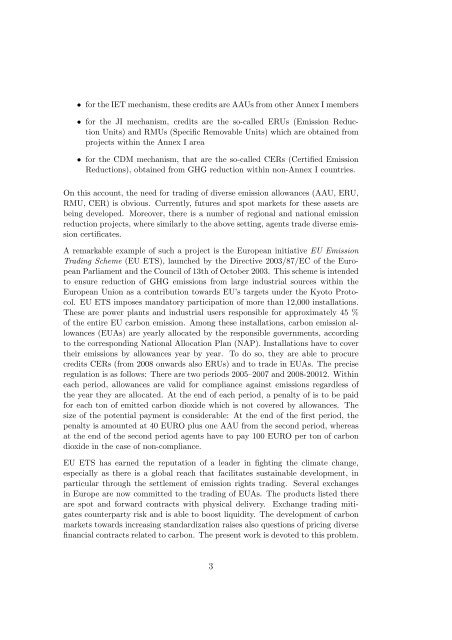A quantitative approach to carbon price risk modeling - CiteSeerX
A quantitative approach to carbon price risk modeling - CiteSeerX
A quantitative approach to carbon price risk modeling - CiteSeerX
Create successful ePaper yourself
Turn your PDF publications into a flip-book with our unique Google optimized e-Paper software.
• for the IET mechanism, these credits are AAUs from other Annex I members<br />
• for the JI mechanism, credits are the so-called ERUs (Emission Reduction<br />
Units) and RMUs (Specific Removable Units) which are obtained from<br />
projects within the Annex I area<br />
• for the CDM mechanism, that are the so-called CERs (Certified Emission<br />
Reductions), obtained from GHG reduction within non-Annex I countries.<br />
On this account, the need for trading of diverse emission allowances (AAU, ERU,<br />
RMU, CER) is obvious. Currently, futures and spot markets for these assets are<br />
being developed. Moreover, there is a number of regional and national emission<br />
reduction projects, where similarly <strong>to</strong> the above setting, agents trade diverse emission<br />
certificates.<br />
A remarkable example of such a project is the European initiative EU Emission<br />
Trading Scheme (EU ETS), launched by the Directive 2003/87/EC of the European<br />
Parliament and the Council of 13th of Oc<strong>to</strong>ber 2003. This scheme is intended<br />
<strong>to</strong> ensure reduction of GHG emissions from large industrial sources within the<br />
European Union as a contribution <strong>to</strong>wards EU’s targets under the Kyo<strong>to</strong> Pro<strong>to</strong>col.<br />
EU ETS imposes manda<strong>to</strong>ry participation of more than 12,000 installations.<br />
These are power plants and industrial users responsible for approximately 45 %<br />
of the entire EU <strong>carbon</strong> emission. Among these installations, <strong>carbon</strong> emission allowances<br />
(EUAs) are yearly allocated by the responsible governments, according<br />
<strong>to</strong> the corresponding National Allocation Plan (NAP). Installations have <strong>to</strong> cover<br />
their emissions by allowances year by year. To do so, they are able <strong>to</strong> procure<br />
credits CERs (from 2008 onwards also ERUs) and <strong>to</strong> trade in EUAs. The precise<br />
regulation is as follows: There are two periods 2005–2007 and 2008-20012. Within<br />
each period, allowances are valid for compliance against emissions regardless of<br />
the year they are allocated. At the end of each period, a penalty of is <strong>to</strong> be paid<br />
for each <strong>to</strong>n of emitted <strong>carbon</strong> dioxide which is not covered by allowances. The<br />
size of the potential payment is considerable: At the end of the first period, the<br />
penalty is amounted at 40 EURO plus one AAU from the second period, whereas<br />
at the end of the second period agents have <strong>to</strong> pay 100 EURO per <strong>to</strong>n of <strong>carbon</strong><br />
dioxide in the case of non-compliance.<br />
EU ETS has earned the reputation of a leader in fighting the climate change,<br />
especially as there is a global reach that facilitates sustainable development, in<br />
particular through the settlement of emission rights trading. Several exchanges<br />
in Europe are now committed <strong>to</strong> the trading of EUAs. The products listed there<br />
are spot and forward contracts with physical delivery. Exchange trading mitigates<br />
counterparty <strong>risk</strong> and is able <strong>to</strong> boost liquidity. The development of <strong>carbon</strong><br />
markets <strong>to</strong>wards increasing standardization raises also questions of pricing diverse<br />
financial contracts related <strong>to</strong> <strong>carbon</strong>. The present work is devoted <strong>to</strong> this problem.<br />
3
















